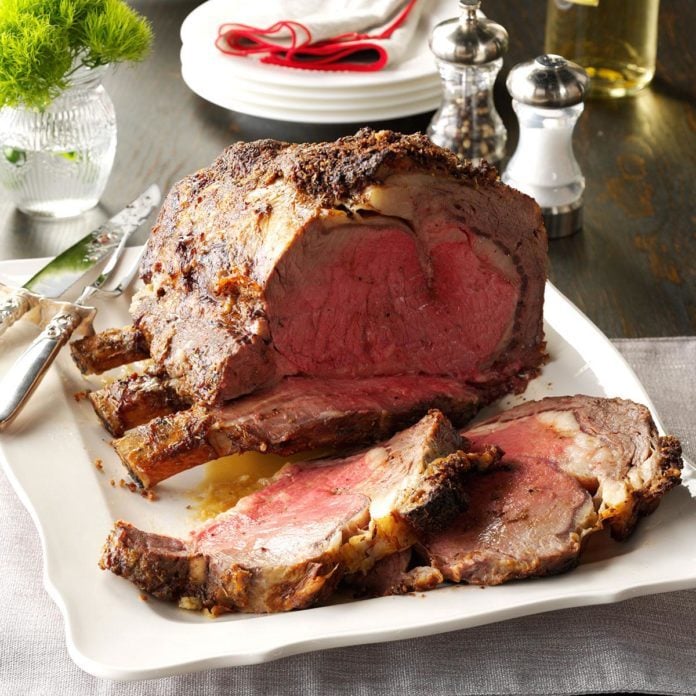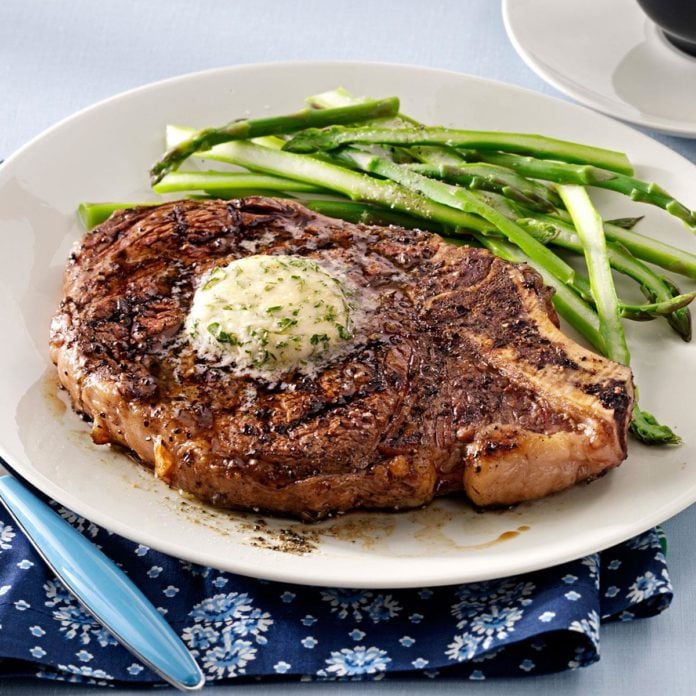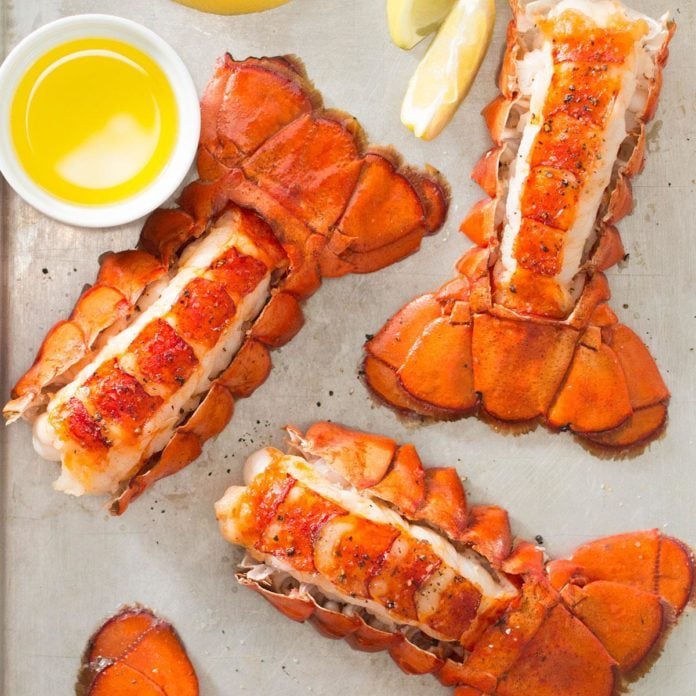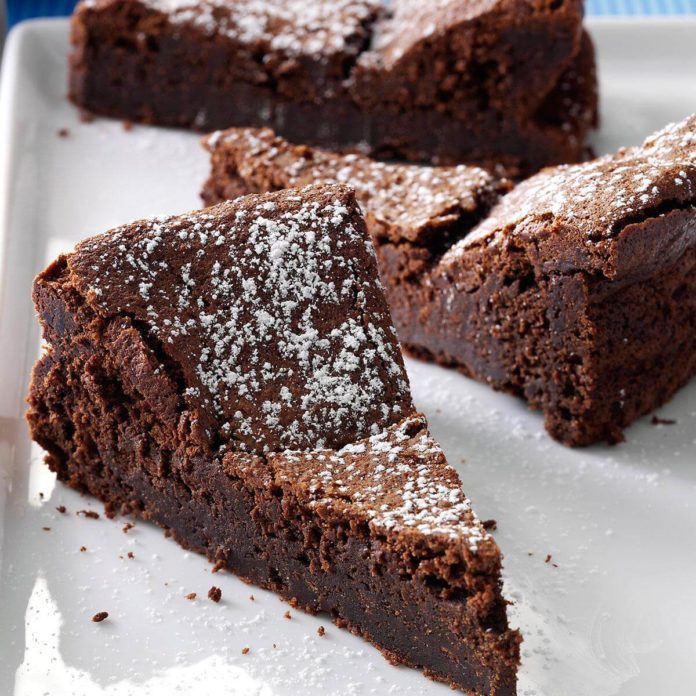If you’ve heard the term “dry-aged beef” before, you probably associate it with a high price tag on a steakhouse menu. Dry-aged steaks are always pricier than the rest of the steaks, so it stands to reason they must taste better, right? Unfortunately, it’s not as cut and dry as that; dry-aged steaks taste different, but whether they’re worth the hefty price tag is up to your taste buds.
What Is Dry-Aged Steak?
A dry-aged steak is exactly what it sounds like: a cut of beef that has been aged, uncovered and surrounded by air. If you pick up a regular steak at the butcher, it’ll be bright red and cook up chewy but juicy (especially when you hit that perfect medium-rare temperature). Dry-aged steaks, on the other hand, aren’t fresh; they’re dark brown in color because they’ve been aged anywhere from 7 to 120 days. They don’t spoil during the process because they’re stored in a humidity- and temperature-controlled environment that keeps them from going bad. They do gain a layer of white mold on the outside of the steak, but don’t worry; this outer layer is always removed before you eat it!
The dry-aging process draws moisture out of the meat, shrinking its size and darkening the color. As the meat loses water, its flavor becomes concentrated to give it a more beef-forward finish. The time in the aging room also breaks down collagen—the connective tissues that holds together the beef’s muscle fibers—so these steaks are more tender than fresh steaks.
See what goes on behind the scenes at your average steakhouse.
What Does Dry-Aged Steak Taste Like?
The first thing you’ll notice about a dry-aged steak is its texture. Because most of the collagen has broken down during the aging process, the steak isn’t as chewy as a regular steak. You may not even need a knife to cut into it; it’s so tender, it almost melts in your mouth as you eat it.
When it comes to flavor, that really depends on how long the beef was aged. The most common dry-aged steak is aged for 30 days. This steak tastes very beefy (similar to a rare roast beef) with a hint of what people describe as buttered popcorn flavor. As it continues to age, the flavor becomes more and more intense. After about 45 days, it starts to take on a funky edge (similar to blue cheese), which continues to intensify at 90 and 120 days. Steaks that are aged this long are very expensive and are best for true beef connoisseurs.
Why Is Dry-Aged Beef Expensive?
The price tag on a dry-aged steak might turn you off, but it’s expensive for a reason. First, it takes time and effort to age a steak, and you need specific equipment. An environment with controlled temperatures and humidity is crucial, and you have to carefully monitor the steaks to make sure they’re only growing beneficial bacteria.
Then, there’s the water loss. When a steak ages for 30 days, it loses 15% of its total weight in water. That means a one-pound steak now weighs 13.6 ounces. At 120 days, that same steak weighs even less; it’s lost 35% of its weight and clocks in at 10.4 ounces. If you’re a restaurant, you would want to account for both the time the steak sat in your inventory and its weight-loss, so every ounce becomes more valuable than the original.
Trying dry-aged steak at a steakhouse is a good way to determine if you like the flavor; you can definitely find it on the menu at the best steakhouse in every state. You can also find dry-aged steak at specialty butcher shops. If the flavor is to your liking, ask if you can special-order large roasts, too. It would be a great way to take your holiday roast to the next level.
Steakhouse Recipes You Can Make at Home
I have served this recipe to people visiting the U.S. from all over the world and to dear friends, family and neighbors. It is enjoyed and raved about by all. It makes an excellent main dish for a Christmas feast. —Kelly Williams, Forked River, New Jersey
Get Recipe
I make this recipe for special occasions. The tantalizing fragrance of the herbs de Provence is unforgettable. The seasoning and herb butter goes well with filet mignon, T-bone and steak strips, too. —John Baranski, Baldwin City, Kansas
Get Recipe
My wife adores this steak—and me when I fix it for her. She thinks it’s the ideal dish for Friday night after a long workweek. —Michael Rouse, Minot, North Dakota
Get Recipe
A wedge salad gets the creamy treatment when topped with blue cheese dressing. Keep the dressing as a topper, or make it a dip for Buffalo wings. —Jenn Smith, East Providence, Rhode Island
Get Recipe
Seven-year-old daughter Heather and I enjoy spending time together cooking, but our days are busy, so we appreciate quick and tasty recipes like this one. Hot and delicious, this soup hits the spot for lunch or dinner. -Sandra Chambers, Carthage, Mississippi
Get Recipe
Wondering how to cook lobster tail? This recipe is for you! No matter where you live, these succulent, buttery lobster tails are just a few minutes away. Here in Wisconsin, we use frozen lobster with delicious results, but if you're near the ocean, use fresh! —Lauren Knoelke, Milwaukee, Wisconsin
Get Recipe
These creamy garlic mashed potatoes are so good, you can serve them plain—no butter or gravy is needed. This is one of our favorite red potato recipes. —Valerie Mitchell, Olathe, Kansas
Get Recipe
Sometimes, I add more mushrooms to this recipe when my son's eating dinner—he loves them, and they are just fantastic with the steak. — Carolyn Turner, Reno, Nevada
Get Recipe
Our region is known for good seafood, and crab cakes are a traditional favorite. I learned to make them from a chef in a restaurant where they were a best-seller. The crabmeat's sweet and mild flavor is sparked by the blend of other ingredients. —Debbie Terenzini, Lusby, Maryland
Get Recipe
For more than 30 years, my brother-in-law Jim kept his famous ribs recipe a secret, much to the chagrin of my husband, Dennis. When he finally came around to sharing it, we loved it so much we just had to pass it along. This one's for you, Jim! —Vicki Young, Brighton, Colorado
Get Recipe
A true Southerner to the core, I love to cook—especially on the grill. This recipe is one of my favorites! The seasoning rub makes a wonderful marinade, and nothing beats the summertime taste of these flavorful grilled steaks! —Sharon Bickett, Chester, South Carolina
Get Recipe
Served as an hors d'oeuvre or a light main dish, these stuffed mushrooms are pretty and delicious. Canned crabmeat becomes absolutely elegant. —Jennifer Coduto, Kent, Ohio
Get Recipe
This recipe represents my philosophy of cooking to its best - cooking with love. A good test to see if you have enough cream in the recipe is to gently press on the top of the layers (once finished). If there is enough cream, you should see it coming out on the sides, but not overflowing. Letting the au gratin rest is very important . . . even though it is so delicious that you would want to jump right in. If you like onions, slice thinly and add in between the layers. —Theresa Danos, Hyde Park, New York
Get Recipe
For an intimate dinner with close friends, serve this stunning dinner of tenderloin steaks and lobster tail. Your guests will think they are dining at a fine restaurant when you serve them this surf and turf dish. —Taste of Home Test Kitchen
Get Recipe
Don’t be afraid to bring out the Brussels sprouts. Mellowed by roasting and tossed with mustard sauce, they may just delight even the most skeptical folks. —Becky Walch, Orland, California
Get Recipe
Cooked spinach makes a perfect accompaniment to many entrees, especially salmon.—Taste of Home Test Kitchen
Get Recipe
Wondering how to make potato skins taste great? I top my restaurant-worthy loaded potato skins with cheese, bacon and a dollop of sour cream. Have them at lunch, snack time or cocktail hour. —Trish Perrin, Keizer, Oregon
Get Recipe
Here is an elegant entree that can be prepared in under 30 minutes! Tender meat and a great peppery flavor is accompanied by a rich cream sauce and fresh shiitake mushrooms. —Barbara Pletzke, Herndon, Virginia
Get Recipe
My favorite dessert is this creme brulee recipe. Recently I was at a party where the guests finished off their own desserts "broiling" the sugar on their portions with a small torch. What a great idea! —Joylyn Trickel, Helendale, California
Get Recipe
Chocoholics—like me!—know that nothing says chocolate like a flourless torte. —Kayla Albrecht, Freeport, Illinois
Get Recipe
The post Do Dry-Aged Steaks Really Taste Better? appeared first on Taste of Home.
Lindsay D. Mattison



















